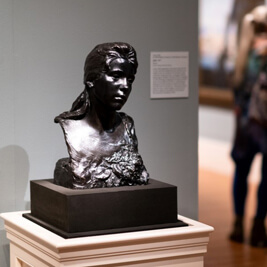- Do + See
- Dine + Host
- Give + Join
- Educate + Learn
Taft Museum of Art’s Diversity, Equity, Access, & Inclusion (DEAI) Plan Executive Summary
The Taft Museum of Art’s DEAI Plan is integral to achieving our vision and mission statements and upholding our organizational and leadership values.
Diversity Statement
The Taft Museum of Art desires to reflect the diversity of our community at every entry point—board, staff, exhibitions, educational programming, and all museum operations. By embedding DEAI into all areas of the museum’s operations, the Taft will champion equitable practices, provide a welcoming and inclusive museum experience, and be accessible to all.
DEAI Pillars
The experiences we offer to the community have diversity, equity, accessibility, and inclusion at their heart but are only a start. While much has been accomplished to date, there is much to learn and more to do. The full board and staff of the Taft embrace the goals and strategies, which will evolve based on lessons learned and on the Taft’s deepening understanding of best and most promising practices.
The Taft seeks to start by addressing five pillars of our museum’s organizational structure with the following pillars:
- Board of Directors | The board will reflect the diversity (race, ethnicity, gender, sexual orientation, et al.) of our community.*
- Staff and Organizational Culture | Taft staff will reflect the diversity (race, ethnicity, gender, sexual orientation, et al.) of our community.*
- Curatorial Practices & Exhibitions | Taft special exhibitions will reflect the diversity of our community, and the permanent art collection will be presented in ways that welcome and engage the diverse audience that we seek.
- Learning & Engagement Programs| Taft learning and engagement programs (school, youth & family, and adult) will connect and engage our community* with art, music, and history through meaningful experiences.
- Museum Operations | The Taft will provide a welcoming environment for all guests, embodying the principles of DEAI across all areas to include its physical space and all departmental practices.
Resources
Definitions
The Taft has adopted the definitions of diversity, equity, accessibility, and inclusion outlined by the American Alliance of Museums. Those definitions are as follows:
- Diversity is all the ways that people are different and the same at the individual and group levels. Even when people appear the same, they are different. Organizational diversity requires examining and questioning the makeup of a group to ensure that multiple perspectives are represented.
- Equity is the fair and just treatment of all members of a community. Equity requires a commitment to strategic priorities, resources, respect, and civility, as well as ongoing action and assessment of progress toward achieving specified goals.
- Accessibility is giving equitable access to everyone along the continuum of human ability and experience. Accessibility encompasses the broader meanings of compliance and refers to how organizations make space for the characteristics that each person brings.
- Inclusion refers to the intentional, ongoing effort to ensure that diverse individuals fully participate in all aspects of organizational work, including decision-making processes. It also refers to the ways that diverse participants are valued as respected members of an organization and/or community. While a truly “inclusive” group is necessarily diverse, a “diverse” group may or may not be “inclusive.”
Community*
For the purposes of tracking our progress, we are using two data metrics to set our diversity goals as follows:
- Hamilton County Census Statistics (as of 7/1/19): Female 51.7%; Non-White 32.5%; Black 26.6%, Hispanic 3.6%, Asian 2.9%, American Indian 0.3%; YP ~35% (age 19–40)
- Cincinnati Metropolitan Statistical Area—Cincinnati, OH-KY-IN (2019 data): Female 51%; Non-White 21%; Black 12%, Hispanic 3%, Asian 3%, American Indian 0%, 2+ Races 3%; YP ~26% (age 19–40).
Diversity Policy
The Taft Museum of Art is an Equal Opportunity Employer and complies with the Civil Rights Act of 1964, the Age Discrimination in Employment Act of 1976, the Americans with Disabilities Act of 1990, and other applicable employment laws. The TMA does not discriminate against employees or applicants for employment on the basis of an individual’s race, color, gender, religion, creed, sexual orientation, national origin, ancestry, age, disability, marital status, veteran status, or any other status protected by applicable law. This policy applies to all terms, conditions, and privileges of employment, including recruitment, hiring, training, placement, compensation, promotion, discipline, and termination.
Questions or comments?
Updated December 2020















